
Life Cycle Assessment of Iron Silicate
The use of our quality-monitored iron silicate products contributes to the protection of the environment, the climate, and natural resources.
Life cycle assessment for road construction, cement, and concrete indicates significant environmental benefits of iron silicate.
As part of our copper refining and recycling processes, we produce iron silicate from mineral components. This industrially produced mineral is comparable to natural minerals from quarries – but unlike quarries, without the disadvantage of massively interfering in nature. Aurubis is a leading global provider of non-ferrous metals and one of the largest copper recyclers worldwide. Iron silicate is used in various applications, especially in construction, as a substitute for primary building materials.
To assess the ecological footprint of building materials, we carried out a life cycle analysis (LCA) for iron silicate products compared to primary building materials. The life cycle analysis shows the environmental impacts of replacing natural mineral building materials with iron silicate products in road construction and cement and concrete production.
The results come to a clear conclusion: using iron silicate products significantly reduces CO2 emissions as well as other environmental impacts.
One example: in the construction of a two-lane road with a length of roughly 400 km, CO2 emissions could be cut by about 11,400 tons if iron silicate were used.1
For a middle class car that drives 12,000 km per year:
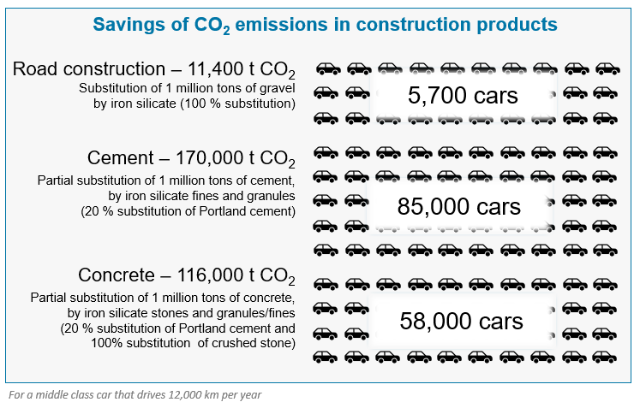
1 Assumptions: Substitution of natural aggregates by iron silicate based on equal volume (instead of mass), i.e. consideration of the different densities of the two materials; road dimensions: 8 m road width, 15 cm gravel base layer; Source: Life Cycle Assessment of different substitution scenarios for iron silicate, Quantis, technical report, September 2020 / own calculation, Aurubis
The use of our iron silicate products can therefore help the construction sector to reduce its CO2 footprint and make a key contribution to the EU’s climate goals. This conserves natural resources while preventing landfilling – in full alignment with the circular economy and the European Green Deal.
The life cycle assessment was conducted in accordance with the recognized methods pursuant to ISO 14040, as well as the global rules of the International Copper Association (ICA) for copper cathodes and the Environmental Footprint category rules for copper sheet. All environmental impacts associated to the production of iron silicate are already accounted for in the copper production process. The only additional environmental impacts come from the further processing, such as crushing or grinding of the material.
The results of the comparative LCA for three different use cases are outlined below.
Use cases of iron silicate

Substituting 1 million tons of gravel from natural aggregate with iron silicate in road construction (100 % substitution) could prevent about 11,400 t of CO₂ equivalent. This could build a two-lane road with a length of roughly 400 km.2
This information results from the life cycle assessment, taking the different densities of the two materials into consideration. A substitution of gravel with iron silicate is assumed on the basis of the volume (instead of the mass).


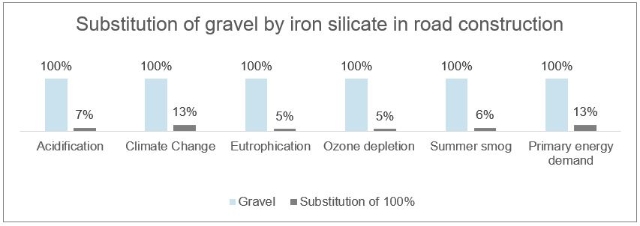
2Source: Life Cycle Assessment of different substitution scenarios for iron silicate, Quantis, technical report, September 2020 / own calculation, Aurubis

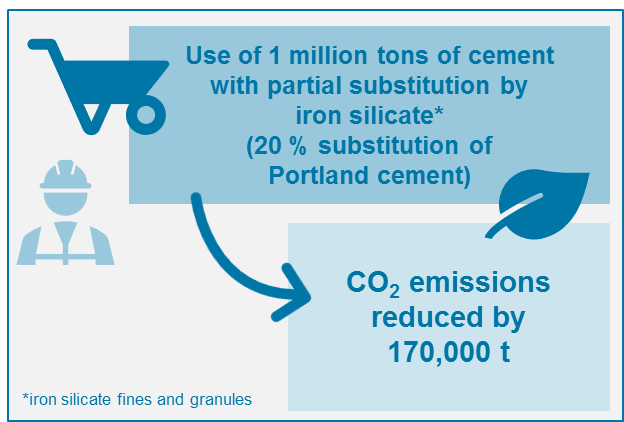
Source: Life Cycle Assessment of different substitution scenarios for iron silicate, Quantis, technical report, September 2020 / own calculation, Aurubis
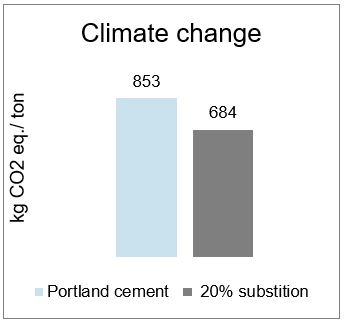

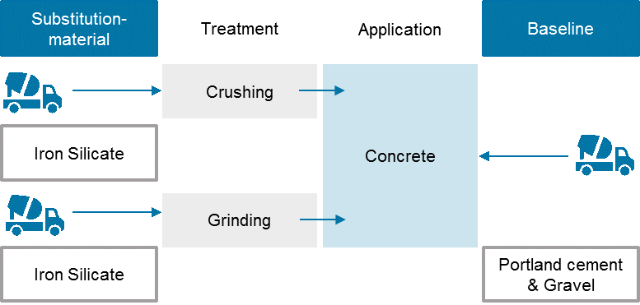
The use of 1 million tons of concrete including iron silicate as a partial substitute (substituting 20 % Portland cement and 100 % natural aggregate) could prevent about 116,000 t of CO₂ equivalent.3
The material composition of the concrete is decisive for the reduction potential. A higher proportion of cement would increase the reduction potential due to the high environmental impact of cement compared to other concrete components.
One example: in the construction of a larger building (in the case in question, a research center), CO2 emissions could be cut by about 12,000 tons if iron silicate were used.4
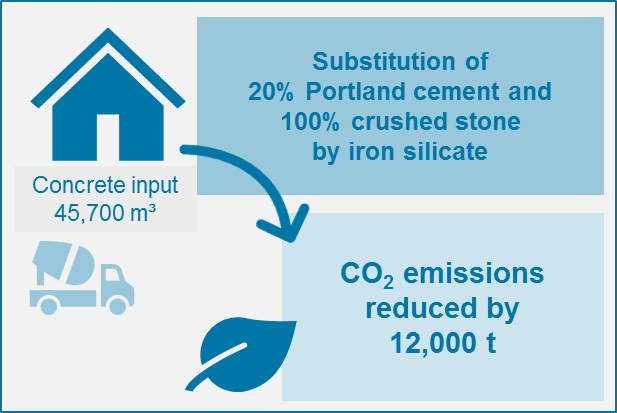


3 Source: Life Cycle Assessment of different substitution scenarios for iron silicate, Quantis, technical report, September 2020 / own calculation, Aurubis
4 Background information on the building in question: area of approx. 24,400 m², maximum height 20 m, approx. 45,700 m³ concrete used; assumptions: 20 % Portland cement and 100 % aggregate replaced by iron silicate
Overview of all impact categories
Acidification [Mol H+ eq.]
The acidification potential is a measure of emissions that have acidifying effects on the environment. It describes the ability of a molecule to increase the hydrogen ion concentration (H+) in the presence of water and thus to reduce the pH level. Emissions with an acidification impact include SO2, NOx, and H2S, which can react in air to become sulfuric acid and nitric acid, fall as “acid rain,” and pollute soil, bodies of water, organisms, and buildings in the process. The lower the acidification potential, the lower the risk of acid rain formation and its associated environmental damages such as the death of fish and forests, as well as damage to construction materials.
Eutrophication [kg P eq.]
The eutrophication potential is a measure of the overfertilization of an ecosystem with nutrients – especially nitrogen and phosphorus. The nutritional enrichment can lead to a negative shift in the composition of species in both aquatic and terrestrial ecosystems, as well as to an increase in biomass production. This generally causes negative consequences for the ecology of bodies of water due to useless and harmful plant growth.
Ozone depletion [kg CFC-11 eq.]
Ozone depletion potential is a measure of the emissions to air that contribute to the depletion of the stratospheric ozone layer. Due to the depletion of the ozone layer, more ultraviolet rays reach the Earth’s surface, which has harmful impacts on people and plants (e.g., disrupting photosynthesis and causing tumors in people and animals). At the same time, the depletion of the ozone layer leads to strong warming of the Earth’s surface. Substances that lead to depletion of the ozone layer include halogenated hydrocarbons that contain fluorine, chlorine, and/or bromine. Some examples are chlorofluorohydrocarbons and halons.
Summer smog [kg NMVOC eq.]
Summer smog, or the photochemical ozone formation potential, is a measure of the emissions of output substances that lead to the formation of smog – mainly ozone – at ground level. This formation is caused by the reaction of volatile organic compounds (VOCs) and carbon monoxide with nitrogen oxides in UV light. Ground-level ozone can be harmful to human health, ecosystems, and crops.
Primary energy demand
Primary energy demand is a life cycle inventory indicator for the entire volume of energy required.
It is a measure of energy demand from both non-renewable resources (e.g., crude oil, natural gas) and renewable resources (e.g., hydropower, wind energy, solar energy). The efficiency in converting energy into electricity, heat, steam, etc. is also taken into consideration.

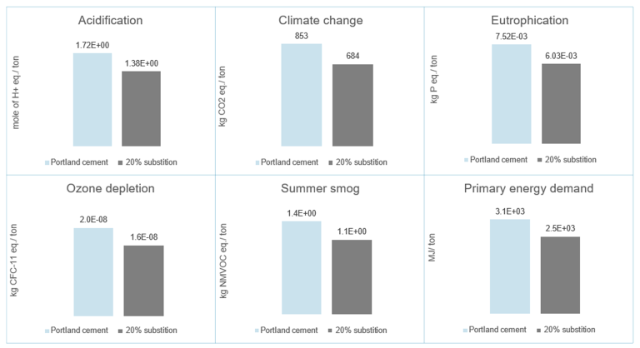
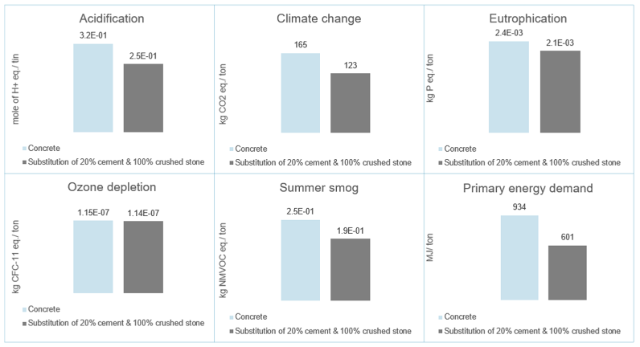
The use of our iron silicate products makes a positive contribution to the environment:
» Proactive climate protection by preventing CO2 emissions in construction
» Resource protection by preventing the extraction of primary material from quarries
» The life cycle assessment confirms environmental benefits of iron silicate compared to “natural” minerals – lower environmental impacts in all LCA categories
Download
-
Um die heruntergeladene Komponente zu sehen den QR code scannen
Iron Silicate: A Versatile and Sustainable Substitute for Natural Minerals
PDF
1 MB
-
Um die heruntergeladene Komponente zu sehen den QR code scannen
Life cycle assessment iron silicate
PDF
1 MB

Dr. Jörn Mühlenfeld
Konzernumweltschutz, Teamleiter REACH
| Phone | +49 40 7883-3663 |